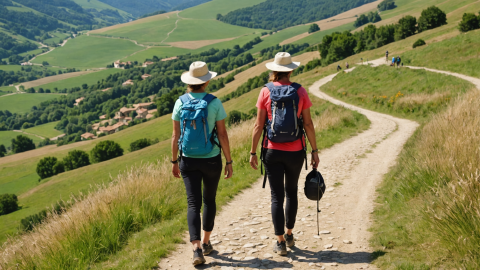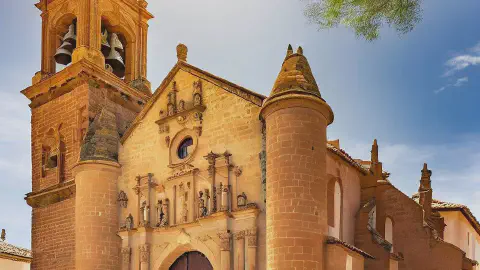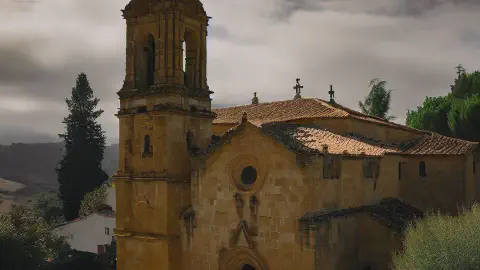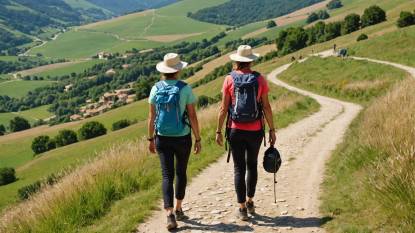
Camino Francés: Navarrete to Grañón - Stage 9
Posted: | Updated:
Reading time: 6 minutes
Camino Francés: Navarrete to Grañón - Stage 9
Posted: | Updated:
Reading time: 6 minutes
By: Simon Kemp , Editor
This stage from Navarrete to Grañón is one of the options you can choose when walking the Camino Francés from Logroño as it break up the journey so you can take your pilgrimage in smaller chunks, depending on your fitness and stamina levels.
The Camino Francés continues its journey from Navarrete, a town deeply rooted in La Rioja’s winemaking heritage, to Grañón, the last village in the region before entering Castilla y León. This stage offers pilgrims a mix of vineyards, rolling hills, and historic landmarks, making it a scenic and rewarding walk.
Historical Background
- Navarrete: Founded in the 12th century, Navarrete has long been an important stop for pilgrims. It was once a fortified town, though its original castle and defensive walls were destroyed in the 16th century. Today, it is known for its pottery workshops, the Church of Santa María de la Asunción, and its connection to the Camino.
- Grañón: This small village has a rich medieval history and is home to the Church of San Juan Bautista, which has welcomed pilgrims for centuries. Grañón is known for its hospitality, with its parish albergue offering a communal experience that many pilgrims cherish.
The Camino Route
The journey from Navarrete to Grañón spans approximately 32 km and is characterized by:
- Scenic vineyards and open countryside, marking the transition into La Rioja’s wine country.
- Historic villages like Ventosa, Nájera, and Santo Domingo de la Calzada, each offering unique cultural and architectural highlights.
- A mix of dirt trails and paved roads, with some gentle ascents and descents.
- Grañón’s welcoming pilgrim atmosphere, marking the end of this stage.
This stage is considered moderately challenging, similar to the previous stage from Logroño to Navarrete, offering a transition from the rolling landscapes of La Rioja into the heart of Castilla y León.
Navarrete to Grañón Camino Route Map
Departure Point: Navarrete
Navarrete, situated in La Rioja wine region of northern Spain, is a captivating town that blends winemaking heritage, historical allure, and breathtaking landscapes.
Location and History
Nestled amidst picturesque vineyards and rolling hills, Navarrete offers a scenic backdrop for wine enthusiasts and nature lovers. With roots dating back to the Middle Ages, the town has been a pivotal player in the region’s winemaking legacy. Its historic center showcases the town’s medieval past, with narrow winding streets, well-preserved stone buildings, and architectural treasures that transport visitors to a bygone era.
Points of Interest
Navarrete boasts captivating landmarks that highlight its rich historical and cultural significance. The Church of the Assumption, an exquisite example of Gothic architecture from the 16th century, stands as an impressive testament to the town’s past. Its intricate stone carvings and splendid interior mesmerize visitors. Nearby, the Pilgrim’s Fountain serves as a tranquil spot where weary pilgrims on the Camino de Santiago can pause and reflect.

Winemaking Heritage
Deeply rooted in La Rioja’s winemaking heritage, Navarrete beckons wine aficionados to explore its bodegas, where world-renowned Rioja wines are crafted. Visitors can indulge in delightful wine tastings that showcase the region’s exceptional vintages. The Wine Museum offers a fascinating journey through the history and techniques of winemaking, providing insights into the artistry behind the production of these renowned wines.
Natural Surroundings
Surrounded by lush vineyards and captivating landscapes, Navarrete offers a gateway to natural wonders. Outdoor enthusiasts can partake in scenic hikes or bike rides through the vineyard-laden countryside, immersing themselves in the beauty of the region. The nearby Sierra de Cantabria mountain range presents thrilling hiking trails and panoramic views, while the serene Ebro River invites relaxation and leisurely walks along its shores.
Camino-related Services
As a significant stop on the Camino de Santiago pilgrimage route, Navarrete caters to the needs of pilgrims with a range of services and amenities. Accommodation options include comfortable hostels and guesthouses. Restaurants and cafes offer nourishing meals and local delicacies, replenishing the energy of weary travelers. Shops provide supplies and pilgrim mementos to commemorate the journey, while support services ensure a smooth pilgrimage experience.
Conclusion
Navarrete, a captivating town situated in La Rioja’s wine region, invites visitors to immerse themselves in its winemaking heritage, historical charm, and awe-inspiring landscapes. Whether you’re a wine enthusiast, a history buff, or a pilgrim on the Camino de Santiago, Navarrete promises an unforgettable experience that captures the essence of this remarkable region in northern Spain.
Destination: Grañón
Grañón is a small town located in the La Rioja region of northern Spain. Known for its rich history, tranquil atmosphere, and warm hospitality, it offers a serene escape for visitors seeking an authentic Spanish experience.
Location and History: Grañón
Nestled amidst rolling hills and expansive fields, Grañón enjoys a picturesque setting in the heart of the Camino de Santiago pilgrimage route. Its origins date back to the 12th century when it served as an important stop for pilgrims on their way to Santiago de Compostela. Today, it continues to welcome weary travelers, providing a peaceful respite along their journey.
Points of Interest: Grañón
Grañón may be a small town, but it is brimming with points of interest that showcase its history. The Church of San Juan Bautista, a Romanesque gem dating back to the 13th century, stands as a prominent landmark. Its ancient stone walls and intricate carvings transport visitors to a bygone era. The town’s Plaza Mayor, a charming square adorned with traditional architecture, invites visitors to relax and soak in the tranquil ambiance.

Pilgrim Hospitality
Grañón is renowned for its unique pilgrim hospitality. The town’s Municipal Albergue, a traditional pilgrim hostel, offers a warm welcome to weary travelers along the Camino de Santiago. Here, pilgrims find not just a place to rest but also a communal atmosphere where they can share stories, forge connections, and experience the camaraderie of the pilgrimage journey. The spirit of hospitality extends beyond the hostel, with local residents often opening their homes to pilgrims.
Natural Beauty
Surrounded by unspoiled countryside, Grañón is a haven for nature enthusiasts. The vast fields and gentle hills that envelop the town invite visitors to embark on leisurely walks, taking in the serene beauty of the landscape. The nearby Sierra de la Demanda mountain range offers more adventurous opportunities for hiking and exploration, rewarding visitors with breathtaking views and a sense of tranquility.
Local Festivals and Traditions
Grañón celebrates its rich cultural heritage through various festivals and traditions. One notable event is the Fiesta de los Danzadores, a unique dance festival held in honor of the town’s patron saint, San Juan Bautista. Locals don traditional costumes and perform intricate dances, keeping alive age-old traditions that have been passed down through generations. The festival is a vibrant celebration of the town’s identity and community spirit.
This town, with its rich history, warm hospitality, and stunning natural surroundings will provide the inspiration you need for the next leg of the Camino Francés from Grañón to Belorado.
Navarrete to Grañón [Video]
Already signed up? Go to Camino Downloads!

